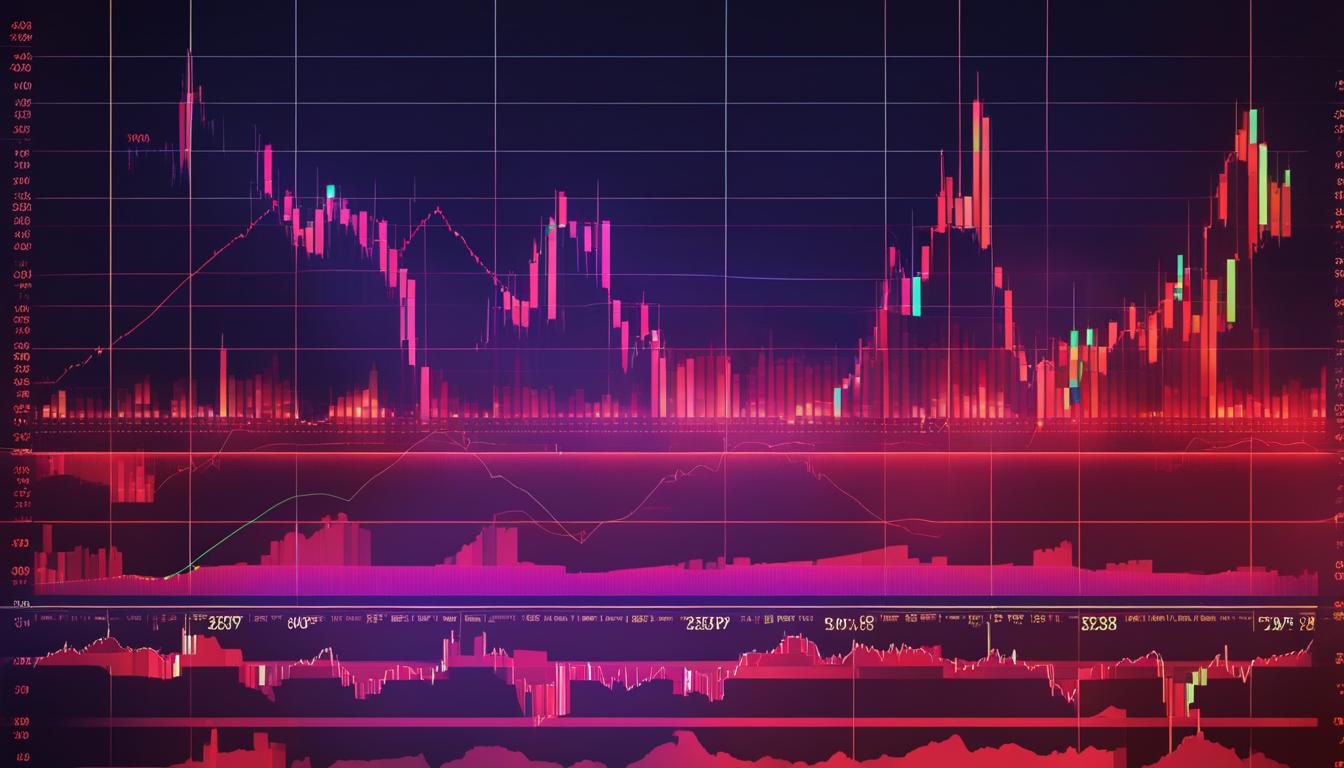Master the Market with the RSI Indicator: A Trader’s Guide

The RSI Indicator is a widely used technical analysis tool for traders. By understanding and mastering the RSI, traders can gain valuable insights into market trends and make informed trading decisions. In this comprehensive guide, we will explore the RSI Indicator in depth, including its calculation, applications, and various trading strategies. Whether you are a beginner or an experienced trader, this guide will equip you with the knowledge and skills to effectively use the RSI Indicator in your trading journey.
Key Takeaways:
- The RSI Indicator is a powerful tool for identifying overbought and oversold conditions in the market.
- Traders can use the RSI Indicator to analyze trend strength and make informed trading decisions.
- Using the RSI Indicator in conjunction with other technical analysis tools can enhance trading strategies.
- Divergence signals on the RSI Indicator can indicate potential trend reversals and trading opportunities.
- Adjusting the RSI settings and time frames can optimize its effectiveness for different trading styles and markets.
What is the RSI Indicator?
The Relative Strength Index (RSI) is a popular technical indicator used by traders to analyze price momentum and identify overbought or oversold conditions in the market. It is a momentum oscillator that measures the speed and change of price movements over a specified period, typically 14 days. The RSI presents this information on a scale ranging from 0 to 100, with values above 70 indicating overbought conditions and values below 30 indicating oversold conditions.
To calculate the RSI, the magnitude of recent gains and losses is compared. The formula involves averaging the gains and losses over the specified period and then calculating the relative strength (RS) as the average gain divided by the average loss. The RSI is then derived from the RS, providing a numerical value that indicates the strength or weakness of a trend.
The RSI indicator is a valuable tool for traders as it helps to identify potential trend reversals and market pullbacks. By analyzing the RSI, traders can gain insights into the market’s strength and make informed trading decisions based on overbought or oversold conditions.
It is important to note that the RSI should not be solely relied upon for trading decisions. It is most effective when used in conjunction with other technical indicators and analysis tools to confirm signals and validate trends. Traders should also consider risk management strategies and market conditions when interpreting RSI signals to minimize potential losses and maximize profits.
Understanding RSI Levels
The RSI indicator provides traders with valuable insight into the market’s strength and potential trend reversals. By interpreting RSI levels, traders can gain a better understanding of market conditions and make informed trading decisions. Here are some key levels to consider:
- An RSI value above 70 indicates that the market is overbought, suggesting a potential trend reversal or pullback.
- An RSI value below 30 suggests that the market is oversold, indicating a potential upward price correction or buying opportunity.
- An RSI value between 30 and 70 indicates a neutral market condition, where the price is neither significantly overbought nor oversold.
Traders should keep in mind that RSI levels alone are not sufficient for making trading decisions. They should be used in conjunction with other technical indicators and analysis tools to validate signals and identify potential market trends.
| RSI Level | Market Condition | Potential Trading Action |
|---|---|---|
| Below 30 | Oversold | Consider buying opportunities |
| 30 to 70 | Neutral | Monitor market conditions |
| Above 70 | Overbought | Consider selling or taking profits |
Understanding RSI as a Trend Indicator
The Relative Strength Index (RSI) is not only a useful tool for identifying overbought and oversold conditions, but it can also be utilized as a trend indicator. By understanding how to interpret the RSI in relation to price trends, traders can gain valuable insights into the strength and direction of the market.
When the RSI is above 50, it suggests a bullish trend, indicating that buying pressure is dominant in the market. Conversely, when the RSI is below 50, it indicates a bearish trend, suggesting that selling pressure is prevailing. However, it is important to note that the RSI alone should not be used as the sole determinant for making trading decisions.
Traders must combine the analysis of the RSI with other technical analysis tools and indicators to confirm trend signals. This holistic approach ensures a more accurate assessment of the market conditions and helps traders make informed decisions. By considering factors such as support and resistance levels, price patterns, and moving averages, traders can gain a comprehensive understanding of the market trend.
Using the RSI in Conjunction with Other Indicators
To enhance the reliability of the RSI as a trend indicator, traders can combine it with other indicators that complement its strengths. For example, the Moving Average Convergence Divergence (MACD) can be used alongside the RSI to validate trend signals. When both indicators provide confirming signals, it increases the confidence level of traders in the accuracy of the analysis.
Another way to use the RSI in conjunction with other indicators is to incorporate volume analysis. Volume can provide insights into the strength of a trend and can help confirm whether the market is participating in the price movement indicated by the RSI. By analyzing the RSI, MACD, and volume together, traders can obtain a more comprehensive view of the market trend, improving their decision-making process.
| Indicator | Strengths | Limitations |
|---|---|---|
| RSI | – Identifies overbought and oversold conditions – Helps determine the strength of a trend |
– Can generate false signals in ranging markets – Should be used in conjunction with other indicators |
| MACD | – Provides trend-following signals – Confirms trend signals from the RSI |
– Can lag behind price movements – May generate false signals during choppy markets |
| Volume Analysis | – Indicates the participation and strength of a trend – Confirms the validity of the RSI signals |
– Can be influenced by external factors – Should be considered alongside price and indicator analysis |
By considering the strengths and limitations of each indicator and using them in conjunction, traders can gain a more accurate understanding of the market trend and make better-informed trading decisions. The RSI, when used in harmony with other indicators, can provide valuable insights into market conditions and help traders navigate the complexities of the financial markets.
Using RSI for Overbought/Oversold Signals
The Relative Strength Index (RSI) is a powerful indicator that traders can use to identify overbought and oversold conditions in the market. When the RSI crosses above 70, it suggests that the market may be overbought, indicating a potential reversal or pullback. This can be seen in Table 1 below, which showcases the RSI levels for various assets that are considered overbought. Traders can use this signal as an opportunity to exit long positions or even consider shorting the asset. However, it’s important to note that an overbought condition does not always lead to an immediate reversal, so other technical analysis tools should be used to confirm the signal.
| Asset | RSI Level |
|---|---|
| Stock A | 75 |
| Currency Pair B | 80 |
| Commodity C | 73 |
On the other hand, when the RSI falls below 30, it suggests that the market may be oversold, presenting a potential buying opportunity. Table 2 provides examples of assets with RSI levels indicating oversold conditions. Traders can use this signal as a chance to enter long positions or consider buying the asset. Again, it’s important to remember that an oversold condition doesn’t guarantee an immediate price increase, so additional analysis is recommended.
| Asset | RSI Level |
|---|---|
| Stock X | 25 |
| Currency Pair Y | 20 |
| Commodity Z | 28 |
The RSI overbought and oversold signals are widely used by traders to guide their trading decisions. By combining these signals with other technical analysis tools, such as support and resistance levels or trend lines, traders can gain a deeper understanding of the market dynamics and potentially improve their trading outcomes.
RSI Divergence: A Powerful Tool
RSI divergence is a valuable technique that traders can use to enhance their trading strategies when using the RSI indicator. It occurs when the price of an asset and the RSI indicator move in opposite directions, indicating a potential trend reversal. Understanding and recognizing RSI divergence can provide traders with valuable insights into market conditions and potential trading opportunities.
“RSI divergence can be a powerful tool for identifying trend reversals and finding entry and exit points in the market.”
– Experienced Trader
There are two types of RSI divergence: bullish divergence and bearish divergence. Bullish divergence occurs when the price forms a lower low while the RSI forms a higher low. This suggests that despite the downward movement in price, the momentum is shifting upwards, indicating a potential trend reversal and a buying opportunity. On the other hand, bearish divergence occurs when the price forms a higher high while the RSI forms a lower high. This signals that despite the upward movement in price, the momentum is decreasing, indicating a potential trend reversal and a selling opportunity.
To effectively utilize RSI divergence, traders should confirm it with other technical analysis tools and indicators. It is important to consider factors such as volume, support and resistance levels, and overall market conditions to validate the potential trend reversal indicated by RSI divergence. By incorporating RSI divergence into their trading strategies, traders can refine their decision-making process and increase their chances of success in the market.
| Bullish Divergence | Bearish Divergence |
|---|---|
| Price forms a lower low | Price forms a higher high |
| RSI forms a higher low | RSI forms a lower high |
| Potential trend reversal | Potential trend reversal |
| Buying opportunity | Selling opportunity |
Different Time Frames for RSI Analysis
The RSI indicator can be applied to different time frames, depending on a trader’s trading style and preferences. The choice of time frame is crucial as it determines the sensitivity of the RSI to price changes and the suitability for various trading strategies. Here are some commonly used time frames for RSI analysis:
Shorter Time Frames
Shorter periods, such as RSI 9 or RSI 5, are more sensitive to price changes and are suitable for day trading or short-term trading strategies. These shorter time frames can provide more frequent trading signals, allowing traders to capitalize on intraday price movements. Day traders can use these signals to identify potential entry and exit points and make quick trading decisions.
Longer Time Frames
On the other hand, longer periods, such as RSI 21 or RSI 50, provide smoother signals and are suitable for swing trading or longer-term analysis. These longer time frames filter out short-term price fluctuations and provide a broader view of the market trend. Swing traders can use these signals to capture medium-term changes in the market and make profitable trades over a few days or weeks.
It is important for traders to choose the time frame that aligns with their trading goals and risk tolerance. The time frame should be selected based on the trader’s preferred trading style and the duration of time they are willing to hold their positions. By using the RSI indicator on different time frames, traders can enhance their trading strategies and improve their overall profitability.
| Time Frame | Sensitivity | Suitable Trading Style |
|---|---|---|
| RSI 9 or RSI 5 | High sensitivity to price changes | Day trading, short-term trading |
| RSI 21 or RSI 50 | Smooth signals, filters out short-term fluctuations | Swing trading, longer-term analysis |
The RSI Indicator for Swing Trading
The Relative Strength Index (RSI) indicator is a valuable tool for swing traders. Swing trading involves capturing medium-term changes in the market trend over a few days, making the RSI overbought/oversold strategy particularly effective. By utilizing the RSI indicator, swing traders can identify potential entry and exit points, enhancing their profitability.
One effective approach for swing traders is to draw trendlines on the RSI oscillator and look for trendline breakouts. These breakouts can signal potential shifts in stock price direction, helping traders anticipate price movements and make profitable trades. By combining the power of trendlines with the RSI indicator, swing traders can gain valuable insights into market trends and make informed trading decisions.
Additionally, swing traders can benefit from using the RSI in conjunction with other technical analysis tools and indicators. By cross-referencing multiple indicators, traders can confirm trading signals and validate their decisions. This multi-faceted approach helps swing traders reduce the risk of false signals and increases the likelihood of successful trades.
Table: Example Swing Trading Strategy using RSI Indicator
| Date | Stock | RSI | Trade Signal |
|---|---|---|---|
| Jan 1, 2022 | ABC | 62 | Hold |
| Jan 2, 2022 | ABC | 77 | Sell |
| Jan 3, 2022 | ABC | 45 | Buy |
| Jan 4, 2022 | ABC | 58 | Hold |
In the example above, the swing trader holds the stock when the RSI is at 62, indicating a neutral stance. However, when the RSI reaches 77, suggesting overbought conditions, the trader sells the stock. Subsequently, when the RSI drops to 45, indicating oversold conditions, the trader buys the stock. This strategy allows swing traders to capitalize on the ebb and flow of market sentiment, maximizing their trading opportunities.
Swing trading with the RSI indicator requires discipline, patience, and continuous monitoring of market conditions. It is essential to adapt the strategy to individual risk tolerance and trading goals. With practice and a deep understanding of the RSI indicator, swing traders can navigate the market with confidence and enhance their overall trading success.
Day Trading with RSI
Day trading with the RSI indicator can be a powerful strategy for capitalizing on short-term price movements in the market. By using a shorter RSI period, such as RSI 9, day traders can gain more sensitivity to intraday signals. To enhance the effectiveness of the RSI, traders often overlay two RSI oscillators with different periods, such as RSI 4 and RSI 9, to generate buy and sell crossover signals.
This approach allows day traders to quickly identify potential entry and exit points based on the RSI indicator. For example, when the shorter period RSI, such as RSI 4, crosses above the longer period RSI, like RSI 9, it can signal a buying opportunity. Conversely, when the shorter period RSI crosses below the longer period RSI, it may indicate a selling opportunity. These crossovers provide day traders with clear indications to make quick trading decisions.
It’s important to note that while the RSI indicator can be a valuable tool for day trading, it should not be relied upon as the sole basis for trading decisions. Day traders should also consider other technical analysis tools, such as trendlines, support and resistance levels, and volume indicators, to confirm the signals generated by the RSI. Combining multiple indicators can help day traders filter out false signals and improve their overall trading performance.
Day Trading with RSI: A Trendline Method
One popular approach in day trading with the RSI is to utilize trendlines drawn on the RSI oscillator. By connecting the highs and lows of the RSI line, traders can identify trendline breakouts that may signal potential price movements. A bullish trendline breakout occurs when the RSI line breaks above the downward trendline, indicating a potential buying opportunity. Conversely, a bearish trendline breakout happens when the RSI line breaks below the upward trendline, suggesting a potential selling opportunity.
Day traders can combine the trendline method with other technical analysis tools, such as candlestick patterns and moving averages, to further enhance their trading strategies. By incorporating these tools into their analysis, day traders can increase their chances of success and make more informed trading decisions.
| Advantages of Day Trading with RSI | Disadvantages of Day Trading with RSI |
|---|---|
|
|
RSI for Cryptocurrency Trading
When it comes to cryptocurrency trading, the RSI indicator can be a valuable tool for traders. By applying the same principles used in traditional markets, crypto traders can leverage the RSI to identify overbought and oversold conditions, as well as bullish and bearish divergences. However, given the unique characteristics of the cryptocurrency market, some adjustments may be necessary.
One important consideration is the use of shorter time frames. Due to the high volatility of cryptocurrencies, using a shorter RSI period, such as RSI 4, can provide more timely signals for intraday trading. By closely monitoring the RSI levels on shorter time frames, traders can capitalize on fast-moving price fluctuations and make quick trading decisions.
Additionally, it’s crucial to incorporate other technical analysis tools and indicators alongside the RSI. The cryptocurrency market is influenced by a variety of factors, including news events, market sentiment, and regulatory developments. By combining the RSI with other indicators, such as trendlines, moving averages, or volume analysis, traders can gain a more comprehensive understanding of the market and increase the accuracy of their trading strategies.
Sample RSI Indicator Settings for Cryptocurrency Trading:
| Time Frame | RSI Period | Recommended |
|---|---|---|
| Short-term (Intraday) | RSI 4 | Yes |
| Medium-term (Swing Trading) | RSI 14 | Yes |
| Long-term (Position Trading) | RSI 21 | No |
Quote: “The RSI indicator can be a powerful ally for cryptocurrency traders, providing insights into the market’s momentum and potential reversals. However, it’s important to remember that no indicator is foolproof, and thorough analysis using multiple tools is always recommended.” – Crypto Trader
By incorporating the RSI indicator into their cryptocurrency trading strategies, traders can gain a competitive edge in the dynamic and volatile crypto market. Implementing RSI-based trading strategies alongside proper risk management techniques can help traders make more informed decisions and ultimately improve their profitability.
The Significance of RSI Levels and Signals
When using the RSI indicator in trading, understanding the significance of different levels and signals is crucial. RSI values above 70 are generally considered overbought, indicating a potential reversal or pullback in price. Conversely, values below 30 are considered oversold, suggesting a potential upward price correction. These levels provide traders with valuable insights into market conditions and possible trading opportunities.
It is important to note that RSI levels should not be interpreted in isolation. Traders should use the RSI in conjunction with other technical analysis tools and indicators to confirm trading signals and make informed decisions. Combining the RSI with indicators such as moving averages or trendlines can provide a more comprehensive view of the market and enhance the accuracy of trading strategies.
In addition to the RSI levels, traders also pay attention to specific signals generated by the indicator. For example, when the RSI crosses above 70, it may signal a potential trend reversal or pullback, providing an opportunity to sell or exit a position. Conversely, when the RSI falls below 30, it may indicate an oversold condition and a potential buying opportunity. These signals can help traders identify entry and exit points and manage their positions effectively.
Using RSI Levels and Signals for Trading
Traders can incorporate RSI levels and signals into their trading strategies in several ways. One approach is to combine RSI signals with other technical indicators. For example, if the RSI generates a bearish divergence signal (higher price high, lower RSI high) and is accompanied by a bearish signal from a moving average crossover, it strengthens the indication of a potential trend reversal.
| RSI Level | Interpretation |
|---|---|
| Above 70 | Overbought, potential reversal or pullback |
| 30 to 70 | Neutral, no clear trend |
| Below 30 | Oversold, potential upward price correction |
Another method is to use RSI levels as dynamic support and resistance levels. When the RSI crosses above 70, the previous resistance level may become a new support level. Conversely, when the RSI falls below 30, the previous support level may act as a new resistance level. These levels can be used to set stop-loss orders or take-profit targets, allowing traders to manage their risk effectively.
Ultimately, the significance of RSI levels and signals lies in their ability to provide valuable information about market conditions and potential trading opportunities. By incorporating the RSI indicator into their trading strategies and using it alongside other technical analysis tools, traders can make more informed decisions and improve their chances of success in the market.
Conclusion
The RSI indicator is an invaluable tool for traders looking to master the market, understand market trends, and generate profitable trading signals. By effectively utilizing the RSI indicator, traders can make informed decisions and improve their overall profitability.
It is important to remember that the RSI should not be used in isolation but should be combined with other technical analysis tools and risk management strategies. By incorporating multiple indicators and analyzing market trends from different perspectives, traders can gain a more comprehensive understanding of the market and make more accurate predictions.
Continuous education and practice are essential in mastering the RSI indicator. Traders should stay updated with the latest market trends, study different trading strategies, and test their approaches in simulated trading environments before implementing them with real money. Additionally, maintaining proper risk management techniques is vital to protect trading capital and minimize potential losses.
In summary, the RSI indicator provides traders with valuable insights into the market, enabling them to identify trends and generate trading signals. By using the RSI in conjunction with other technical analysis tools and risk management strategies, traders can increase their chances of success and achieve their trading goals.
FAQ
What is the RSI Indicator?
The Relative Strength Index (RSI) is a momentum oscillator that measures the speed and change of price movements. It compares the magnitude of recent gains and losses over a specified period and presents the information on a scale ranging from 0 to 100. Traders use the RSI to identify overbought and oversold conditions in the market and to generate trading signals.
How can the RSI be used as a trend indicator?
The RSI helps traders identify the strength and direction of a price trend. When the RSI is above 50, it indicates a bullish trend, while a reading below 50 suggests a bearish trend. However, it is important to use the RSI in conjunction with other technical analysis tools for accurate trend analysis.
How can the RSI be used to identify overbought and oversold conditions?
When the RSI crosses above 70, it suggests that the market may be overbought, indicating a potential reversal or pullback. When the RSI falls below 30, it suggests the market may be oversold, presenting a potential buying opportunity.
What is RSI divergence and how can it be used?
RSI divergence occurs when the price of an asset and the RSI indicator move in opposite directions. Bullish divergence happens when the price forms a lower low while the RSI forms a higher low, suggesting a potential trend reversal and a buying opportunity. Bearish divergence occurs when the price forms a higher high while the RSI forms a lower high, indicating a potential trend reversal and a selling opportunity.
How does the RSI indicator vary with different time frames?
The RSI can be applied to different time frames based on a trader’s trading style and preferences. Shorter periods, such as RSI 9 or RSI 5, are more sensitive to price changes and are suitable for day trading or short-term trading strategies. Longer periods, such as RSI 21 or RSI 50, provide smoother signals and are suitable for swing trading or longer-term analysis.
How can the RSI be used for swing trading?
Swing traders can use the RSI overbought/oversold strategy to identify potential entry and exit points. By drawing trendlines on the RSI oscillator and looking for trendline breakouts, swing traders can anticipate price movements and make profitable trades.
How can the RSI be used for day trading?
For intraday signals, a shorter RSI period, such as RSI 9, is recommended. Overlaying two RSI oscillators with different periods, such as RSI 4 and RSI 9, can generate buy and sell crossover signals. This approach allows day traders to capitalize on short-term price movements and make quick trading decisions.
Can the RSI indicator be used for cryptocurrency trading?
Yes, the RSI principles can be applied to cryptocurrency trading. Crypto traders can use the RSI to identify overbought and oversold conditions, as well as bullish and bearish divergences. They may need to adjust the RSI settings and use shorter time frames, such as RSI 4 for intraday trading, due to the volatility of the cryptocurrency market.
What is the significance of RSI levels and signals?
RSI values above 70 are generally considered overbought, indicating a potential reversal or pullback, while values below 30 are considered oversold, suggesting a potential upward price correction. Traders should interpret RSI levels in conjunction with other technical analysis tools and indicators to confirm trading signals and make informed decisions.
How can the RSI indicator help traders in the market?
The RSI is a powerful tool for traders to analyze the market, identify trends, and generate trading signals. By understanding how to effectively use the RSI and incorporating it into their trading strategies, traders can make more informed trading decisions and improve their overall profitability. However, it should not be used in isolation, but rather in conjunction with other technical analysis tools and risk management strategies.







